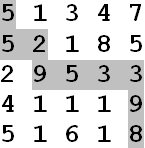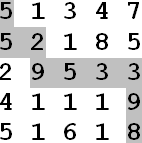NASA plănuiește o nouă misiune Rover pe Marte în anul 2020. Principalul obiectiv al acestei misiuni este de a determina, cu ajutorul unui nou Rover, dacă a existat în trecut viață pe Marte. Până când va fi lansată misiunea, Roverul este supus la tot felul de teste în laboratoarele NASA. Într-unul din teste, Roverul trebuie să parcurgă o suprafață de forma unui caroiaj cu linii și coloane. Acesta pornește din zona de coordonate și trebuie să ajungă în zona de coordonate , la fiecare pas putându-se deplasa din zona în care se află într-una din zonele învecinate la nord, sud, est sau vest. Pentru fiecare zonă de coordonate se cunoaște , stabilitatea terenului din acea zonă. Știind că Roverul are o greutate , o zonă cu stabilitatea terenului cel puțin egală cu se consideră o zonă sigură pentru deplasarea Roverului, iar o zonă cu stabilitatea terenului mai mică decât se consideră o zonă periculoasă pentru Rover.
Cerințe
- Determinați numărul minim posibil de zone periculoase pe care le traversează Roverul pentru a ajunge din zona în zona .
- Determinați greutatea maximă pe care o poate avea un Rover care să ajungă din zona în zona , fără a traversa nicio zonă periculoasă pentru el.
Date de intrare
Pe prima linie a fișierului de intrare rover.in se găsește numărul natural a cărui valoare poate fi doar sau . Dacă este , pe a doua linie a fișierului de intrare se găsesc două numere naturale și cu semnificația din enunț, iar dacă este , pe a doua linie a fișierului de intrare se află doar numărul .
Pe următoarele linii se află câte numere , reprezentând stabilitatea terenului din zona .
Date de ieșire
Fișierul de ieșire este rover.out.
Dacă valoarea lui este , atunci fișierul de ieșire va conține pe prima linie un număr natural reprezentând numărul minim de zone periculoase pe care trebuie să le traverseze Roverul de greutate .
Dacă valoarea lui este , atunci fișierul de ieșire va conține pe prima linie un număr natural reprezentând greutatea maximă a unui Rover care poate ajunge din zona în zona fără a traversa zone periculoase pentru el.
Restricții și precizări
- Zonele de coordonate și nu sunt zone periculoase pentru Rover.
- Roverul nu va trece de mai multe ori prin aceeași zonă.
| Punctaj | |
|---|---|
| 45 | |
| 45 |
Exemplul 1
rover.in
1
5 5
5 1 3 4 7
5 2 1 8 5
2 9 5 3 3
4 1 1 1 9
5 1 6 1 8
rover.out
3
Explicație
Numărul minim de zone periculoase traversate de la poziția până la poziția este .
Un traseu posibil este:

Exemplul 2
rover.in
2
5
5 1 3 4 7
5 2 1 8 5
2 9 5 3 3
4 1 1 1 9
5 1 6 1 8
rover.out
2
Explicație
Greutatea maximă a unui Rover care poate ajunge din zona în zona fără a trece prin zone periculoase pentru el este .
Un traseu posibil este:
